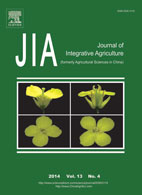|
|
Impacts of Fertilization Alternatives and Crop Straw Incorporation on N2O Emissions from a Spring Maize Field in Northeastern China
YANG Li , WANG Li-gang, LI Hu, QIU Jian-jun , LIU Hui-ying
2014, 13(4):
881-892.
DOI: 10.1016/S2095-3119(13)60496-7
Spring maize is one of the most popular crops planted in northeastern China. The cropping systems involving spring maize have been maintaining high production through intensive management practices. However, the high rates of nitrogen (N) fertilizers application could have introduced a great amount of nitrous oxide (N2O) into the atmosphere. It is crucial for sustaining the maize production systems to reduce N2O emissions meanwhile maintaining the optimum yields by adopting alternative farming management practices. The goal of this study was to evaluate effects of alternative fertilization and crop residue management practices on N2O emission as well as crop yield for a typical maize field in northeastern China. Field experiments were conducted during the 2010-2011 maize growing seasons (from early May to late September) in Liaoning Province, northeastern China. N2O fluxes were measured at the field plots with six different treatments including no N fertilizer use (CK), farmers’ conventional N fertilizer application rate (FP), reduced N fertilizer rate (OPT), reduced N fertilizer rate combined with crop straw amendment (OPTS), slow-release N fertilizer (CRF), and reduced N fertilizer rate combined with nitrification inhibitor (OPT+DCD). The static chamber method combined with gas chromatography technique was employed to conduct the measurements of N2O fluxes. The field data showed that N2O emissions varied across the treatments. During the maize growing season in 2010, the total N2O emissions under the treatments of CK, FP, OPT, OPTS, and CRF were 0.63, 1.11, 1.03, 1.26, and 0.98 kg N ha-1, respectively. The seasonal cumulative N2O emissions were 0.54, 1.07, 0.96, 1.12, and 0.84 kg N ha-1, respectively, under CK, FP, OPT, OPTS, and OPT+DCD in 2011. In comparison with FP, CRF or OPT+DCD reduced the N2O emissions by 12 or 21%, respectively, while the crop yields remained unchanged. The results indicate that the reduction of N-fertilizer application rate in combination with the slow-release fertilizer type or nitrification inhibitor could effectively mitigate N2O emissions from the tested field. The incorporation of crop residue didn’t show positive effect on mitigating N2O emissions from the tested cropping system. The field study can provide useful information for the on-going debate on alternative N fertilization strategies and crop straw management in China. However, further studies would be needed to explore the long-term impacts of the alternative management practices on a wide range of environmental services.
|
